On the ground with districts and nonprofits who are embracing recent policy changes to feed children in their communities.

On the ground with districts and nonprofits who are embracing recent policy changes to feed children in their communities.
July 29, 2024
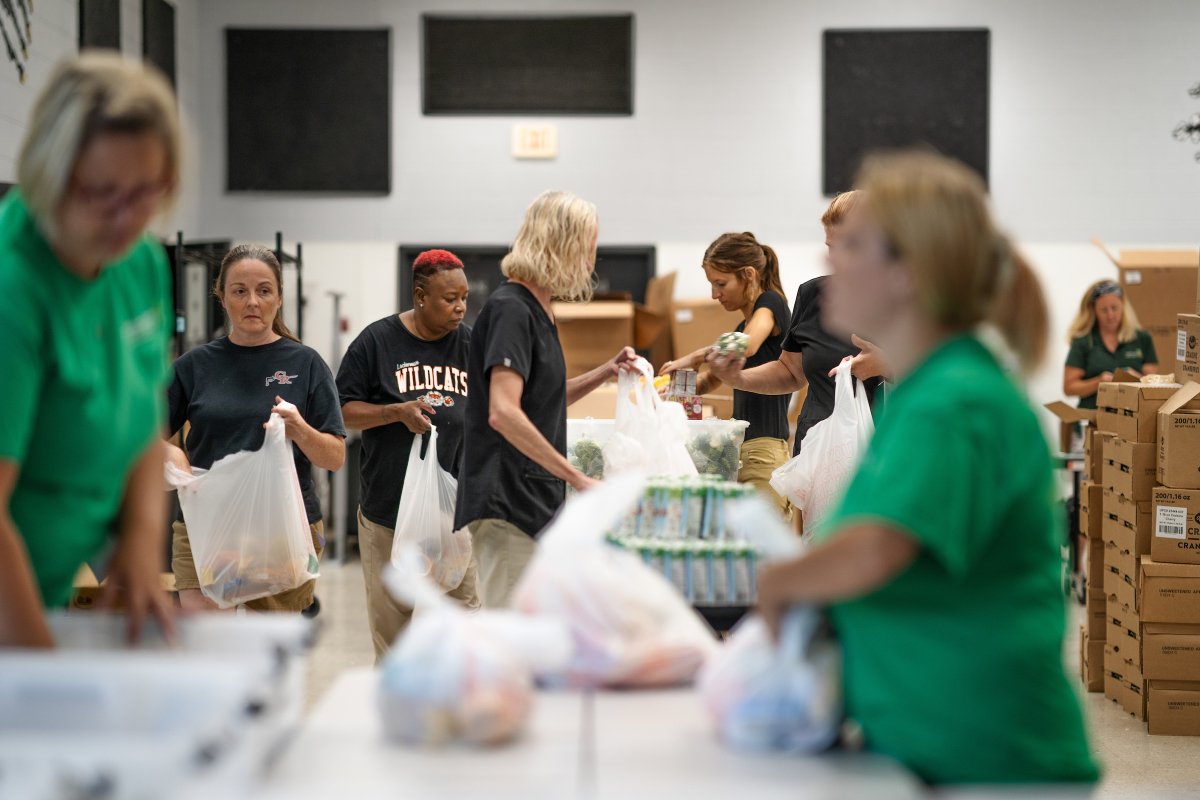
Cafeteria workers at Lockerman Middle School work in an assembly line to pack bags filled with three days of meals. (Photo credit: Colin Marshall)
At the end of May, Samantha Figueroa sat at her desk counting the number of sites where Caroline County Public Schools would distribute free food to children this summer. Behind her, color-coded meal plans filled the wall.
“People think, ‘It’s almost summertime; you must get a vacation!’” said Figueroa, the food operations manager for the small district in eastern Maryland. “But I am running around like a maniac.”
That’s because while cafeteria workers serve meals in nine Caroline County schools during the school year, they would be operating 24 sites between June and August. In addition to serving meals at camps and other places children gather during the summer, at 17 of those, her team would be sending applesauce cups, baked ziti, and milk cartons out into communities in a whole new way. Other districts and nonprofits all over the country are doing the same thing this summer.
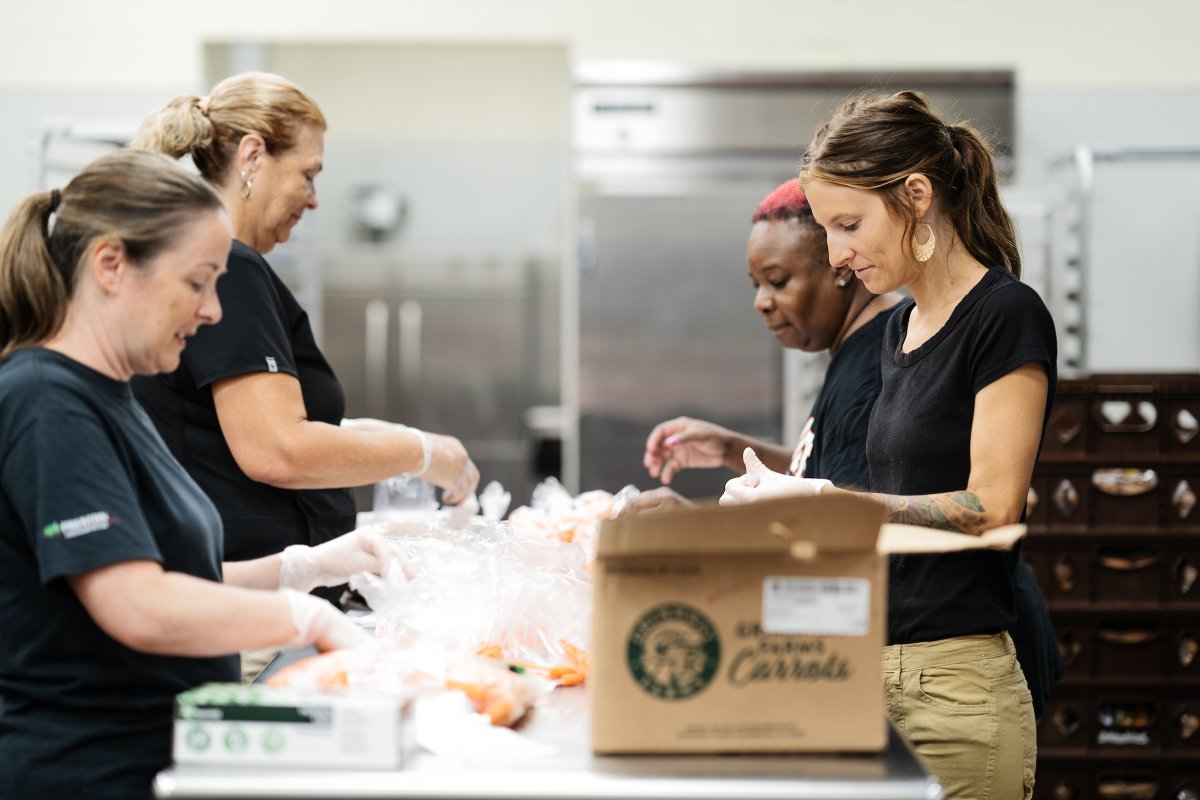
Vegetables like baby carrots have to be packaged into individual serving sizes before they’re added to meal bags. (Photo credit: Colin Marshall)
Driving it all is a policy change members of Congress, led by Senators Debbie Stabenow (D-Michigan) and John Boozman (R-Arkansas), quietly tucked into a December 2022 spending bill. In addition to authorizing a program that would put extra funds into low-income parents’ pockets for summer groceries, the lawmakers changed a longstanding provision that required schools to serve summer meals communally, eliminating the requirement for rural areas.
While it may seem like a tiny detail, school food professionals and child hunger organizations have long argued that in the past, requiring children to show up and sit down to eat had prevented them from reaching many food-insecure households during the summer months. That was especially true in rural areas, where families are spread out and transportation options can be limited. In low-income districts like Caroline County—where all kids eat free during the school year—they argued, kids were likely going hungry as a result.
This summer, then, marks a turning point.
“It truly is a historic moment. We have the opportunity to do something that folks have been trying to do for a very long time,” said U.S. Deputy Secretary of Agriculture Xochitl Torres Small at No Kid Hungry’s Summer Nutrition Summit in January. “By giving kids the nutrition they need, we’re giving them a foundation of well-being that can—without exaggeration—change the trajectory of their lives.”
But while the policy tweak may be simple, the 400 professionals at the conference were there to talk about the hard part: logistics. It’s profoundly complicated to find hungry kids who are out of school, prepare, pack, and deliver meals to them—and to do it all while following U.S. Department of Agriculture (USDA) rules that come with unwieldy paperwork. In short, they were laying the foundation for what Figueroa and countless other school food professionals are now working on every week this summer.
By early July, on a morning when hot air hung heavy over the crisp, browned grass outside Lockerman Middle School, Figueroa had worked through many of those details.
Inside the school, which had been transformed into the district’s summer meal command center, staff members worked in an assembly line packing plastic bags. They opened up boxes of breakfast burritos, Pop-Tarts, and personal pizzas. They reached for individually packed bags of fresh broccoli, cherry tomatoes, and loose oranges. There were chicken patty and potato wedge platters packaged to be easily microwaved, and plenty of milk. Cardboard boxes filled with roasted chickpea snacks, Craisins, and Blueberry Chex were stacked throughout the cafeteria.
It might have felt more chaotic if they hadn’t done this before, but they had. “We have PTSD from COVID,” Figueroa said, “but we learned the rhythm and the way to set this up and make it efficient.”
The USDA calls this kind of meal service—which doesn’t involve kids sitting down next to each other with trays—“non-congregate.” While hunger groups had been advocating for the approach for many years, the pandemic provided the test case for the power of the practice. With emergency waivers in hand, schools and nonprofits were freed up to feed students—now learning in their homes all over the place—however they could manage it.
Figueroa’s team sprang into action in 2020, with bus drivers delivering meals, Parks & Recreation employees donating vehicles, and volunteers from the community helping out. While it was born of necessity, it showed them the possibilities and where, exactly, the need was.
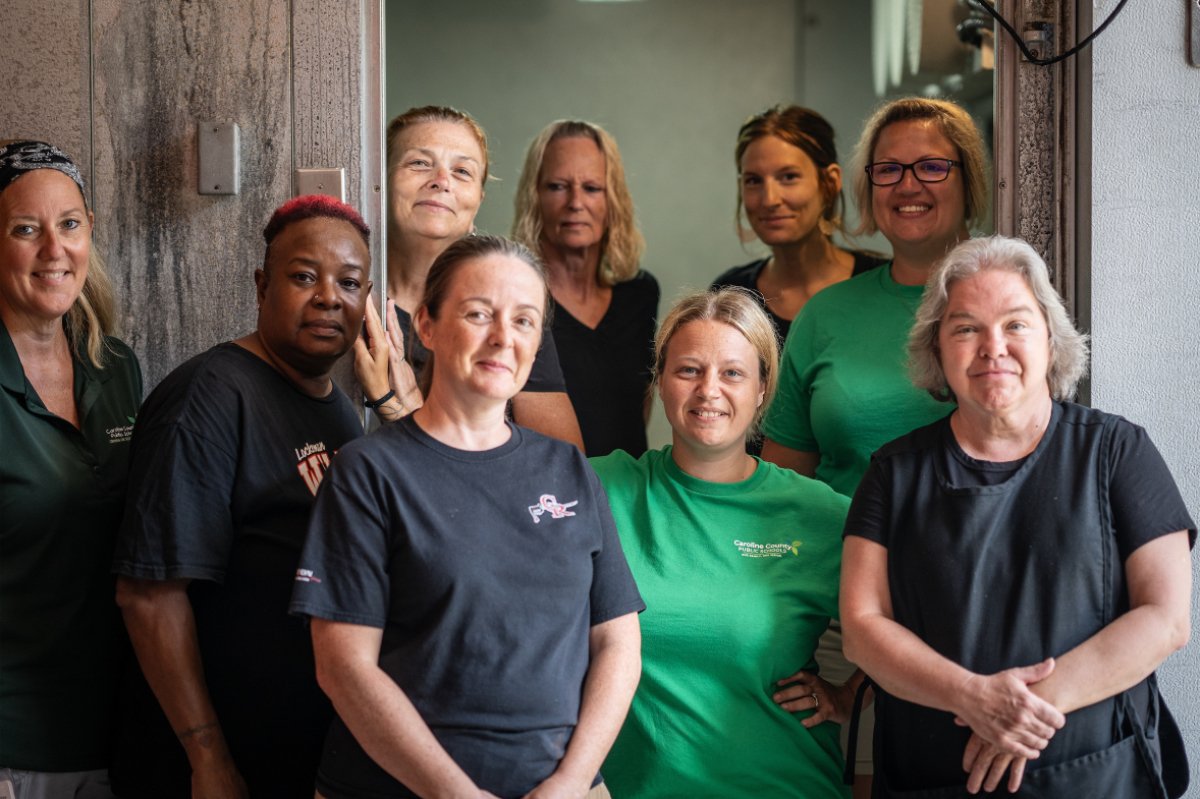
The team of women who unload boxes, prep meals, preserve vegetables, and package bags of meals to be distributed all summer long in Caroline County. (Photo credit: Colin Marshall)
“We were going into neighborhoods, apartment complexes, mobile-home sites,” she said. “Those are the places we went during COVID, where there was a need. Now, we know where those kids will be.”
At Feeding Southwest Virginia, a nonprofit that runs summer meal programs in multiple counties, Director of Children’s Programs Brandon Comer said she saw the scramble to get food to families during the pandemic as a sort of pilot program for non-congregate meal service. Plus, the challenges her team handled during that time made her feel like now they could do anything.
“It couldn’t get any worse than that. Literally, in 2021, USDA made a decision to approve some of the waivers, and we were already halfway through the summer, but we made it work,” Comer said. “COVID just about killed me, but we made sure we fed kids.”
At the peak of her pandemic service, she had 42 meal sites running. This summer, she has 67, 35 of which are adopting the non-congregate option. Many sites are in the arrowhead-shaped span of far southwest Virginia that juts between Kentucky and Tennessee, where rural poverty runs deep.
And now that the change has become law, the USDA issued more specific rules around it, one of which has had huge implications for Comer’s operations. In January, the agency tweaked how it defines “rural,” a change that more than doubled how many Virginia schools qualified this year—up to 120 from 50 last year.
“Some of the areas we were feeding congregate before, but now we can turn them into non-congregate, which enables us to get more kids fed because we’re not spending an hour and a half at a feeding site and then driving 45 minutes and spending an hour and a half at a feeding site and then having to come back,” she said. “We can do three, four, or five in a day now.”
In Craig County on the state’s western edge, for example, a librarian called to propose distributing meals last year, but the area did not meet the definition of rural. This year, it did. When Comer added the site to her routes, the library estimated they’d feed 150 kids. Once word got out, she began upping the number, which is now around 350 kids a week.
Back on Maryland’s Eastern Shore, Figueroa didn’t have to worry about that change. “We’re 100 percent rural, so we’re going everywhere,” she said.
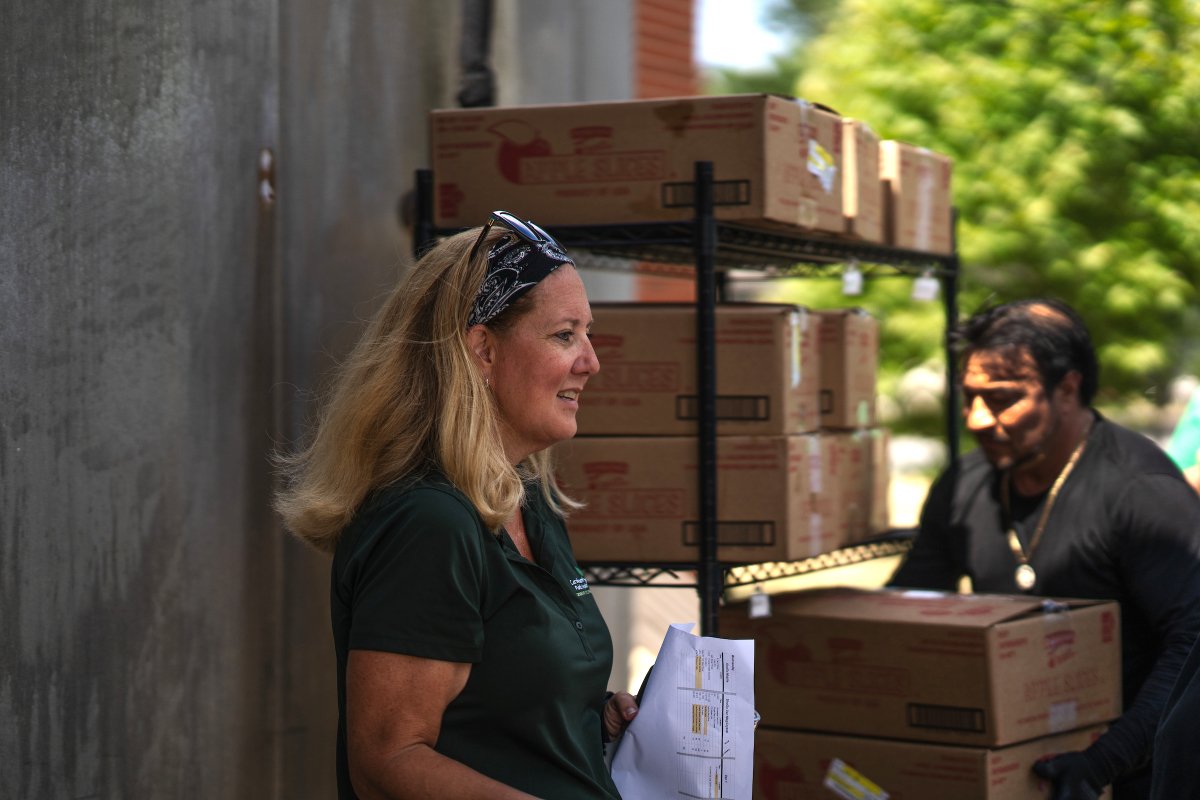
Samantha Figueroa checks her timeline of multiple meal delivery routes while boxes of incoming produce are stacked behind her. (Photo credit: Colin Marshall)
While her team fed plenty of kids last summer, the biggest difference this year is “it’s a lot more food,” said Liz Alley, a member of Figueroa’s team who runs the Lockerman operation. Alley pointed to print-outs she had taped to an easel, where below the different locations and routes planned for each day, she was tallying meal counts. By the end of the day, they’d send out 1,400 meals.
Mid-morning, van driver Meghan Hewitt pulled up with her helper, a high-school student fulfilling community service hours. As the two rearranged bins filled with bags of food so that cartons of milk jugs wouldn’t fall over in transit, a tractor trailer pulled in. “Produce is here!” one of the cafeteria employees yelled, as a delivery worker began moving pallets of grapes, apples, peaches, and honeydew melons from his truck into a stationary refrigerated truck used for storage.

Meghan Hewitt drives the van slowly through the neighborhood, tapping her horn to alert families of the arriving meals. (Photo credit: Colin Marshall)
In the meantime, Hewitt set out, and after a quick distribution at a small condo complex, she drove north.
The van, decorated with colorful images of fruits and vegetables, passed a warehouse where zucchini, squash, and green beans from local farms was stored. The Lockerman cafeteria team has recently blanched and vacuum-sealed the vegetables to be used for lunch service during the upcoming school year . It passed corn and soybean fields stretching out on either side of the highway.
Then, Hewitt arrived at the destination: a mobile home park that housed many of the immigrant families who harvest the fruits and vegetables grown in the county’s fields.
As she pulled into the neighborhood, she began gently, repeatedly tapping the horn outside homes where she had identified—a few weeks earlier—that children were present. It was no ice cream truck, but mothers ushered their children out to greet her at the sound of the arrival.
Sweat dripped off her forehead as she carried bags of food and milk jugs to their doorsteps, tallying each on a clipboard with a smile. Families expressed their thanks and then hurried back inside trailers plagued by disrepair as the sun bore down, the strained hum of rusted, aging air conditioners filling the air.
Much further south, in Florida, Sky Beard directs her state’s No Kid Hungry campaign, which provides grants to schools and nonprofits running summer meal programs. She said that last year, even though most schools weren’t able to get the non-congregate programs off the ground in time, she had already heard how the rule change was helping expand efforts to curb child hunger.
“What we heard last year is that this meets the needs of their communities like nothing else,” she said. In her state, it’s even more critical, she said: Despite new survey data showing one in five kids in the state live in food-insecure households, Governor Ron DeSantis’ administration chose not to participate in Summer EBT, the other program that came out of Congress’ 2022 changes. DeSantis also rejected earlier, COVID-related summer food aid dollars for kids and is one of more than a dozen governors, all Republicans, who have rejected the latest federal funds.
Summer EBT, which the USDA has rebranded as “Sun Bucks,” is an extra benefit of $40 per month provided to families whose children qualify for free meals during the school year. In places where the two changes are being rolled out and adopted at the same time, advocates say the combination is a powerful one-two punch.
“With summer EBT in conjunction with our summer feeding programs, it’s an opportunity to make up for the loss of meals that a child will experience” when school is closed, said LaMonika Jones, who runs Maryland Hunger Solutions and D.C. Hunger Solutions, both initiatives of the Food Research & Action Center (FRAC). “We know we had greater participation with non-congregate meals during the pandemic. So, this is an opportunity for us to extend that and for us to continue to make improvements to the summer feeding program.”
In Maryland, Jones has been helping rural districts implement non-congregate meal programs while also helping families access summer EBT benefits. In Washington, D.C., her focus has been on those latter benefits, since the region is entirely urban.
“I’ve been sharing with my staff for the last couple of months as an FYI: ‘Be on the lookout and listen up. Parents may be calling,’” she said. While many students will automatically be enrolled in Summer EBT through other nutrition-assistance programs, there are always cracks people fall through, and each state’s system for distributing the benefits is slightly different. Jones’ group communicates how the program works so that families know how and when to expect benefits—and what to do if things don’t work the way they’re supposed to.
For example, she said, a benefit card might be mailed in an unlabeled envelope, which gets accidentally thrown away. “That’s another question that I get,” she said. “‘I was waiting for a summer EBT benefit to arrive, but I never got it. What do I do?’”
Jones and her team keep information on hand to direct families to the right offices where they can get help and access resources they’re eligible for.
That’s the thing about federal meal programs: While the work of feeding children is as elemental as survival, sustenance, and good health, the most challenging parts of the work often involve administrative headaches and paperwork.
Improved nutrition standards in school meals, for example, have successfully moved the needle on improving the health of low-income students. But for Figueroa’s team showing up to chop broccoli, those standards can make the job harder and often feel like red tape, because the rules are incredibly specific. And what each meal contains during the school year is different than what it must consist of in the summer.
“We’re receiving federal funds, and we want to do it right. We have to do it right. We get reviewed, we get audited, we get inspected all the time, but we also want to feed our kids,” Figueroa said. “Sometimes all of the politics and rules make it hard to just feed a kid a hamburger.”
One of her biggest challenges, which Brandon Comer in Virginia echoed, is monitoring all the different sites, especially as the non-congregate option takes off. The USDA requires that the districts and nonprofits running summer meal programs provide oversight of all the locations at which they distribute meals. Depending on how new the site is, it may mean a member of the management team will have to go to that site multiple times to evaluate its performance.
Another is staffing. “Ever since COVID, we have not been able to [fully] staff,” Comer said. Finding truck drivers is especially difficult, so the team ends up using smaller vehicles, which requires more trips and therefore more time. Still, she is making it work and expects her meal numbers to be 25 to 30 percent higher than they were last summer.
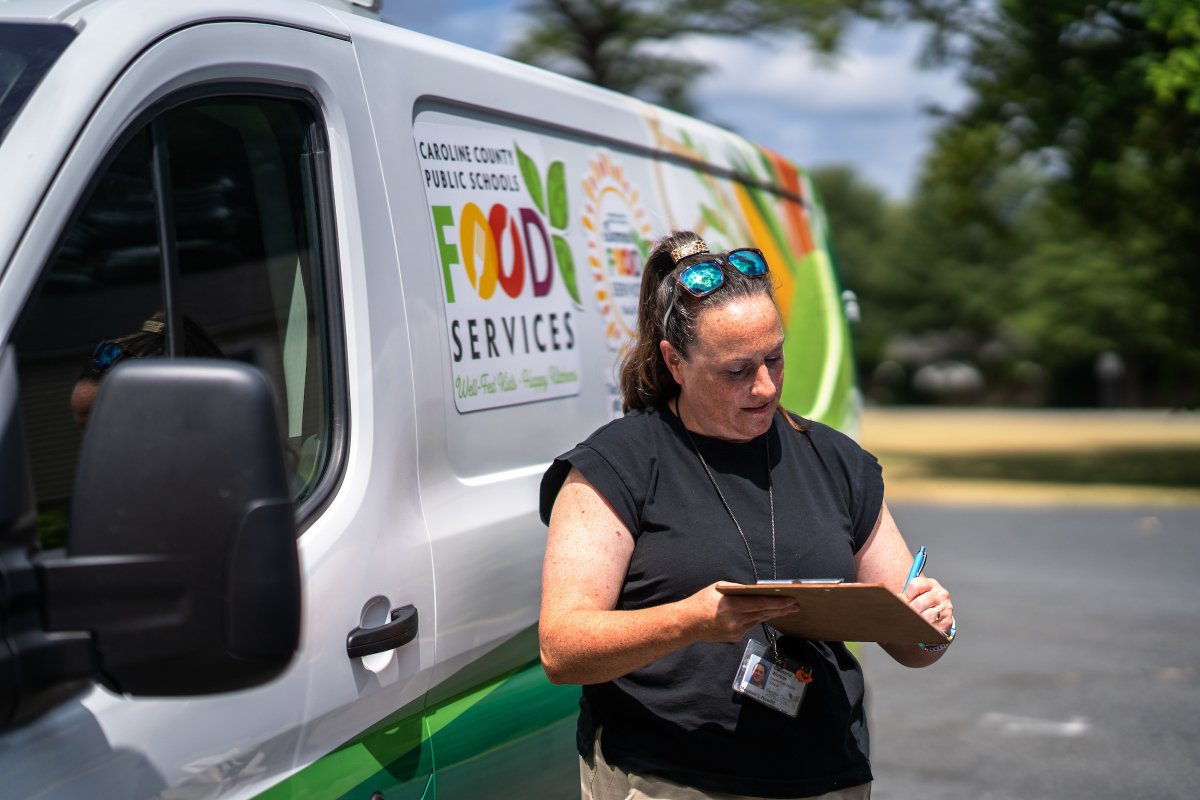
Meghan Hewitt marks each meal distributed on her spreadsheet so that meal totals can later be reported to USDA. (Photo credit: Colin Marshall)
While COVID taught her she could make anything work, both she and Figueroa said they’re hoping these recent policy shifts stick around so that they can ultimately build systems that last, rather than having to figure out new plans as June approaches. “I feel like every year is a trial run,” Figueroa said, “but I’m hoping this is the year where next year, I won’t have to write a million different menus because hopefully we’re in a final rule that we can stick with.”
Whatever happens, each week this summer until school starts, the staff at Lockerman will be unpacking boxes and packing bags of meals over and over, while Meghan Hewitt and others drive their vans around Caroline County, beeping to let families know they’ve arrived.
“It’s not always easy for them to get to us,” Figueroa said. “We’ve got to go to them.”

September 4, 2024
By paying top dollar for milk and sourcing within 15 miles of its creamery, Jasper Hill supports an entire community.
September 3, 2024

August 27, 2024

August 26, 2024

Like the story?
Join the conversation.